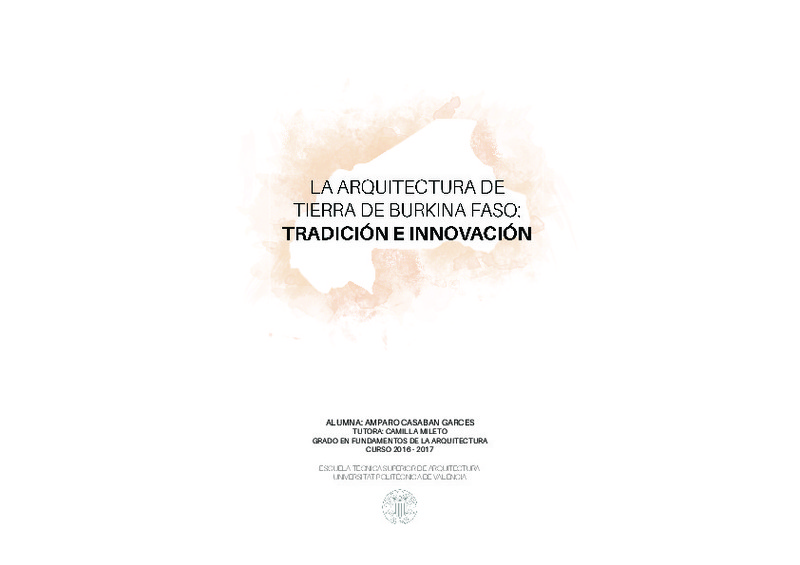JavaScript is disabled for your browser. Some features of this site may not work without it.
Buscar en RiuNet
Listar
Mi cuenta
Estadísticas
Ayuda RiuNet
Admin. UPV
La arquitectura de tierra de Burkina Faso: tradición e innovación
Mostrar el registro sencillo del ítem
Ficheros en el ítem
| dc.contributor.advisor | Mileto, Camilla
|
es_ES |
| dc.contributor.author | Casabán Garcés, Amparo
|
es_ES |
| dc.coverage.spatial | east=-1.5615930000000162; north=12.238333; name=Centre Region, Burkina Faso | es_ES |
| dc.date.accessioned | 2018-05-25T14:48:09Z | |
| dc.date.available | 2018-05-25T14:48:09Z | |
| dc.date.created | 2017-07-14 | |
| dc.date.issued | 2018-05-25 | es_ES |
| dc.identifier.uri | http://hdl.handle.net/10251/102664 | |
| dc.description.abstract | [ES] La tierra es uno de los materiales de construcción más antiguos y utilizados en todo el mundo y especialmente en países como Burkina Faso, donde la facilidad de obtención del mismo, así como sus diversas formas de aplicación la convierten en un recurso óptimo para la edificación. La influencia europea ha propiciado la incorporación de nuevos materiales, como el bloque de hormigón y la chapa metálica, que nada tienen que ver con la tradición constructiva, el clima y la sociedad del país. A raíz de la situación de insostenibilidad económica, ecológica y social que supone la utilización de estos materiales constructivos, cada vez son más las obras que utilizan la tierra, en nuevos formatos y diseños mejorados, como material de construcción principal, devolviendo prestigio y uso a un material socialmente ignorado y desprestigiado. | es_ES |
| dc.description.abstract | [EN] Earth is one of the oldest and most used building materials worldwide and especially in countries like Burkina Faso, where the ease of obtaining it, as well as the forms of application make it an optimal resource for building. European influence has led to the incorporation of new materials, such as concrete block and sheet metal, which do not have to do with the constructive tradition, climate and society of the country. As a result of the economic, ecological and social unsustainability situation due to the use of these building materials, more and more buildings are being built with earth, in new formats and improved designs, as main building material, restoring prestige and use to a material socially ignored and discredited. | es_ES |
| dc.format.extent | 82 | es_ES |
| dc.language | Español | es_ES |
| dc.publisher | Universitat Politècnica de València | es_ES |
| dc.rights | Reserva de todos los derechos | es_ES |
| dc.subject | Vernacular architecture | es_ES |
| dc.subject | Traditional architecture | es_ES |
| dc.subject | Earthen architecture | es_ES |
| dc.subject | Cooperation | es_ES |
| dc.subject | Burkina Faso | es_ES |
| dc.subject | África | es_ES |
| dc.subject | Arquitectura vernácula | es_ES |
| dc.subject | Arquitectura tradicional | es_ES |
| dc.subject | Arquitectura de tierra | es_ES |
| dc.subject | Cooperación | es_ES |
| dc.subject | ADAUA | es_ES |
| dc.subject | FARE Studio | es_ES |
| dc.subject | Albert Faus | es_ES |
| dc.subject | Francis Kéré | es_ES |
| dc.subject | hac-90 arquitectes slp | es_ES |
| dc.subject.classification | COMPOSICION ARQUITECTONICA | es_ES |
| dc.subject.other | Grado en Fundamentos de la Arquitectura-Grau en Fonaments de l'Arquitectura | es_ES |
| dc.title | La arquitectura de tierra de Burkina Faso: tradición e innovación | es_ES |
| dc.type | Proyecto/Trabajo fin de carrera/grado | es_ES |
| dc.rights.accessRights | Abierto | es_ES |
| dc.description.bibliographicCitation | Casabán Garcés, A. (2017). La arquitectura de tierra de Burkina Faso: tradición e innovación. http://hdl.handle.net/10251/102664 | es_ES |
| dc.description.accrualMethod | TFGM | es_ES |
| dc.relation.pasarela | TFGM\21616 | es_ES |
Este ítem aparece en la(s) siguiente(s) colección(ones)
-
ETSA - Trabajos académicos [4677]
Escuela Técnica Superior de Arquitectura






